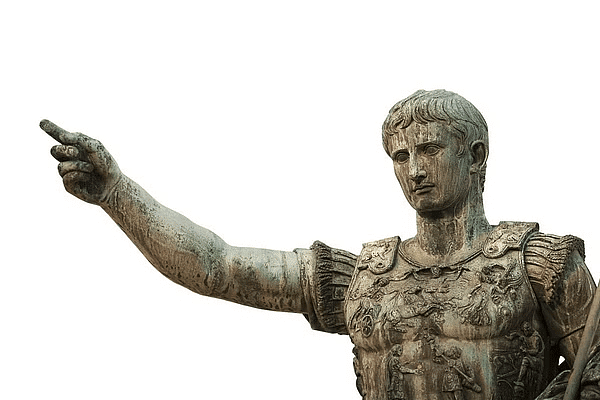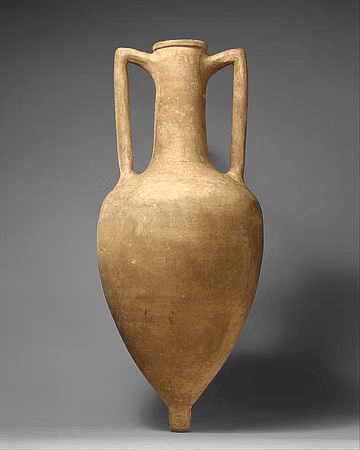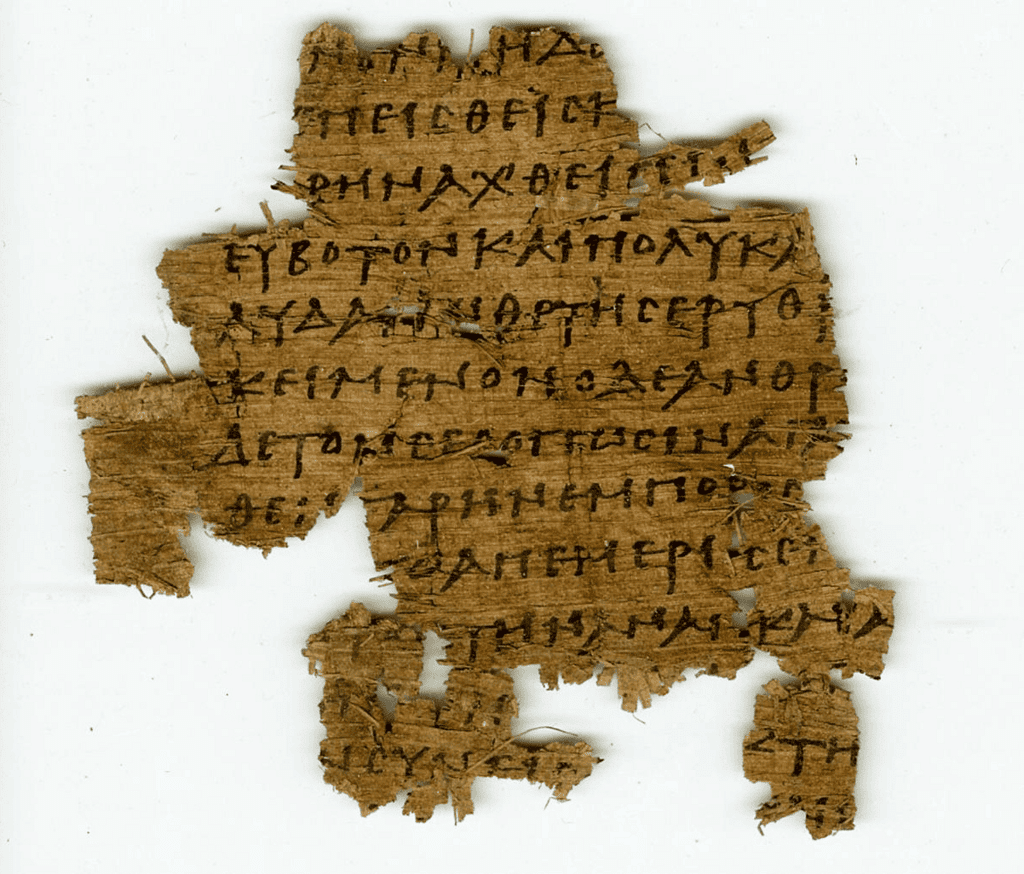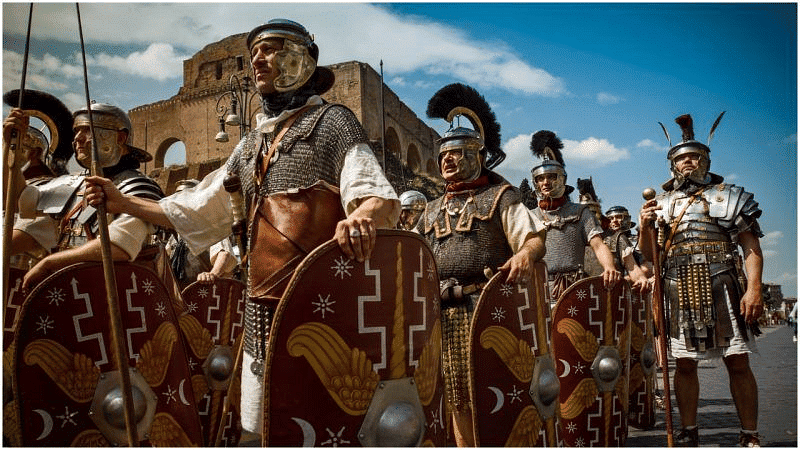Class 11 History Short Questions with Answers - An Empire Across Three Continents
Very Short Question With Answer (1 Mark Each)
Q1: What formed the boundaries of the Roman Empire to the north as well as south?
Ans: The boundaries of the Roman Empire were formed by the geographical diversities of the continents, formed in the north by the rivers Rhine and Denube and to the south, they were formed by the huge expanse of desert called the Sahara.
Q2: Which two languages were used in the administration of Roman Empire?
Ans: Two languages used in administration of the Roman Empire included:
(i) Latin
(ii) Greek
Q3: Why was Roman ruler Augustus considered the ‘leading citizen’?
Ans: Roman ruler Augustus was considered as the ‘leading citizen’ only to show that he was not the absolute ruler. It was done out of respect for the Senate. Caeser AugustusQ4: Which empire’s army was a conscripted army?
Caeser AugustusQ4: Which empire’s army was a conscripted army?
Ans: The army of Persian empire was a conscripted army or which is forcibly recruited. It means that military service was compulsory for some adult males of the state.
Q5: State any two features of the Roman army.
Ans: Two features of the Roman army include:
- The Roman army was professional in which every soldier was paid a salary.
- Soldiers were put in a minimum of 25 years of service.
 Roman Army
Roman Army
Q6: Which were the three main players in the political history of Rome?
Ans: The three main players in the political history of Rome include:
1. The emperor
2. The aristocracy
3. The army
Q7: What was the base of membership of Senate in Rome?
Ans: The Senate, a group controlled by a few wealthy families known as the ‘nobility’, offered a membership for life, the basis for which was wealth and the office-holding more than birth.
Q8: What is meant by the Civil War?
Ans: Armed struggle between two groups of a country to capture power is known as the Civil War. Apart from one infamous year (69 CE) when four emperors ascended the throne rapidly, the first two centuries of the Roman rule were generally free from civil war and relatively stable.
Q9: For what the age of Roman emperor Augustus is known and why?
Ans: Augustan age is known for the peace. It was so because this peace came in after the decades of internal conflict and centuries of military conquests.
Q10: What is meant by the Near East of Rome?
Ans: For someone living in the Roman Mediterranean, this term referred to all the land east of the Mediterranean, primarily the Roman provinces of Syria, Palestine, and Mesopotamia, as well as the surrounding areas, such as Arabia.
Q11: What was the importance of great urban centres in imperial system of Rome ? Write names of the three largest urban centres of Rome?
Ans: The great urban centres were the true bedrock of the imperial system in Rome. The Government was able to tax the provincial countrysides through these cities which generated major portion of the wealth of the empire. Carthage, Alexandria and Antioch were three largest urban centres of Rome.
Q12: What steps did the emperor Gallienus take to prevent control of the empire from falling into Senator’s hands?
Ans: Emperor Gallienus took the following steps to prevent control of the empire from falling into Senator’s hands:
- He consolidated the rise of power of the new elites.
- He excluded Senators from military command.
 Emperor GallienusQ13: In the third century Rome, what did the trends of majority of provincial Senators reflect?
Emperor GallienusQ13: In the third century Rome, what did the trends of majority of provincial Senators reflect?
Ans: The trends of majority of provincial Senators were characterised by:
- These trends reflected that there was the general decline of Italy within the empire from political and economic perspective.
- These trends reflected that there was a rise of new elites in the wealthier and more urbanised parts of the Mediterranean.
Q14: What is meant by a ‘city’ in the Roman sense?
Ans: In Roman sense, a city was an urban centre which had its own magistrates, city council and a definite territory. This territory contained many villages under its jurisdiction.
Q15: Why were public baths opposed in Iran?
Ans: The clergy of Iran viewed water as a sacred element and to use it for public bathing seemed a desecration to them. This is the reason why public baths were opposed in Iran.
Q16: In the third century, rulers of which dynasty of Iron and which Germanic tribes invaded the Roman Empire?
Ans: In the third century, rulers of the Sasanian dynasty of Iran and Germanic tribes, namely the Alamanni, the Franks and the Goths invaded the Roman Empire.
Q17: How were Roman women self dependent?
Ans: Women were free to exercise the following under the Roman empire:
- Roman women were given enough legal rights in owing and managing property.
- Divorce was relatively an easy affair.
Q18: What were Amphorae? Where were they made?
Ans: Amphorae were a type of containers. They were used in transporting liquids like wine and olive oil. They were made in the Mediterranean region. AmphoraeQ19: Name four densely populated areas of Roman empire (two each from Italy and Egypt).
AmphoraeQ19: Name four densely populated areas of Roman empire (two each from Italy and Egypt).
Ans: Densely populated areas of Roman empire included:
- Campania, Italy
- Sicily, Italy.
- Fayum, Egypt
- Galilee, Egypt.
Q20: From where did the best kinds of wine and wheat come to Rome?
Ans: Rome procured the best kinds of wine and wheat from the following:
1. Wine: from Campania
2. Wheat: Sicily and Byzacium.
Short Question With Answer (2-4 Marks Each)
Q1: Describe the major sources of Roman history.
Ans: The major sources of Roman history can be broadly divided into three groups :
- Texts: Letters, speeches, sermons, laws, histories of the period written by contemporaries, etc., are included in it.
- Documents: Inscriptions and papyri are included in it. Inscriptions were generally cut on stone which is why they have survived even till today. Thousands of contracts, letters, accounts and official documents have survived on papyrus which was a reed like plant and whose leaves were used for writing.
- Material remains: These include monuments, buildings, other kinds of structures, coins, pottery, mosaics, entire landscapes, etc. Each of these remains give us specific information about the Roman past.
 Papyri
Papyri
Q2: Discuss the expansion of the Roman and Iranian empires.
Ans: Until the 630s, Europe, North Africa, and the Middle East were ruled by two powerful rival empires: Rome and Iran. They were separated by a narrow strip of land along the river Euphrates.
- The Roman Empire:
Dominated the Mediterranean and surrounding regions, with boundaries formed by the Rhine and Danube rivers in the north and the Sahara desert in the south. - The Iranian Empire:
Controlled the area south of the Caspian Sea to eastern Arabia and parts of Afghanistan. These empires divided much of the known world, referred to as ‘Ta ch’ in Chinese.
Q3: Give a brief description of the Republican System of the Roman Empire.
Ans: The Republican System of the Roman Empire was the system of government in which the real power vested in the Senate. Members of the Senate enjoyed a life-long term. For it, wealth and prestige of office were of more importance. So the Senate was dominated by rich people, known as the 'nobility'. In practice, Republic was a government of the elites, which was run by an institution, namely the Senate. Republic government was there from 509 BCE to 27 BCE. In 27 BCE it was overthrown by Julius Caesar’s adopted son and successor Octavian (later Augustus) and he himself became the emperor of Rome.
Q4: What is meant by the ‘Principate’ in context of the Roman Empire ? What was the position of emperor and the Senate in it ?
Ans: The Principate was established by Augustus in 27 BCE. Although Augustus was the sole ruler, he maintained the fiction of being merely the 'leading citizen' to respect the Senate, which had previously controlled Rome during the Republic. The Senate, representing the aristocracy and wealthy families, remained a powerful institution for centuries. Emperors were judged by their behavior towards the Senate, with hostile emperors considered the worst. Many senators longed for the return of the Republic days, but most likely understood that this was not feasible.
Q5: Briefly describe the role of army in the early Roman Empire.
Ans:
The Roman army was a major institution and a paid professional force, requiring a minimum of 25 years of service from each soldier. This paid army was a distinctive feature of the Roman Empire.
The army had significant power to determine the fate of emperors due to its size and organization. Constant agitations for better wages and conditions often led to mutinies.
The Senate feared and hated the army because it was a source of violence. The success of emperors depended on their control of the army; divided armies typically led to civil wars.
 The Roman Army
The Roman Army
Q6: What was the significance of provincial and local rule of the early Roman Empire?
Ans:
Provincial Rule:
- The Roman Empire gradually extended direct rule by capturing many dependent kingdoms, particularly in the Near East.
- By the early second century, Rome had absorbed these wealthy kingdoms, except for Italy.
- All territories were divided into provinces and taxed.
Local Rule:
- Numerous cities were established across the empire, serving as the basis of the imperial system.
- These urban centers enabled the government to tax the provincial countryside, becoming a major source of the empire's wealth.
Q7: Who were the three main players in the political history of the Roman Empire ? Write two or three sentences about each of them.
Ans: The three main players in the political history of the Roman Empire were the emperor, the elite group and the army.
- The Emperor: The emperor was the sole ruler of the empire, but he was called the leading citizen. This was done out of respect for the Senate. It also showed that he was not the absolute ruler.
- The Elite Group: The elite group stood for the Senate. It included members of the aristocracy and wealthy families. It controlled Rome in the days when it was a Republic. Emperors were judged by how they behaved towards the Senate. Emperors who were hostile to the Senate were considered the worst.
- The Army: Next to the emperor and the Senate was the army. It was a professional one. Each soldier was paid a salary. The army had the power to determine the fate of emperors.
Q8: What was a ‘city’ in the Roman sense? Also tell some characteristics of the urban life.
Ans: In the Roman sense, a city was an urban centre which had its own magistrate, city council and a definite territory. This territory contained many villages under its jurisdiction. So one city could not be a part of another city. Decision about the status of a city or village depended upon royalty. Villages could be given the status of cities, and vice-versa.
Characteristics of the urban life :
- There was no shortage of food in cities.
- Cities had better facilities during famines than the countryside.
- Urban people enjoyed a higher level of entertainment. For example, one calendar tells us that sphectacula shows filled not less than 176 days of the year.
Q9: By giving example, explain that the Roman Empire faced a lot of strain in the third century.
Ans: The Roman empire faced a lot of strain in the third century. It would be clear from the following examples:
In 225 C.E., the aggressive Sasanian dynasty emerged in Iran and quickly expanded towards the Euphrates. Shapur I claimed to have destroyed a Roman army of 60,000 and captured Antioch, as recorded in a famous rock inscription.
From 233 to 280 C.E., Germanic tribes (Alamanni, Franks, Goths) repeatedly attacked the Roman frontiers, forcing the Romans to abandon territories beyond the Danube.
The emperors of this era frequently battled these invasions, with the rapid succession of emperors in the 3rd century highlighting the empire's struggles.
Q10: There was widespread cultural diversity in the Roman Empire. Give some examples.
Ans: There is no doubt that there was widespread cultural diversity in the Roman Empire. This diversity was reflected in many ways and at many levels.
- There was vast diversity of religious cults and local deities.
- There was plurality of spoken languages.
- People wore various styles of dress and costume.
- People enjoyed different kinds of food.
- Forms of social organisation were different.
- Their patterns of settlement were of various types.
|
25 videos|98 docs|20 tests
|
FAQs on Class 11 History Short Questions with Answers - An Empire Across Three Continents
| 1. What continents did the empire in the article cover? |  |
| 2. How did the empire expand across three continents? |  |
| 3. What were some of the key cultural influences of the empire on the three continents? |  |
| 4. How did the empire's rule impact the local populations in the three continents? |  |
| 5. What led to the decline of the empire across the three continents? |  |

|
Explore Courses for Humanities/Arts exam
|

|




















